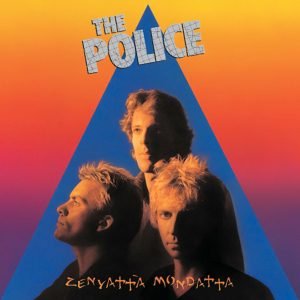By the time Zenyatta Mondatta arrived in 1980, The Police had already carved out a space for themselves as one of the most distinctive bands of the post-punk and New Wave era. Their first two albums had mixed punk energy with reggae grooves and pop hooks, and this third release didn’t veer far from that formula. Instead of making a sharp turn, the band built on what they already did well—tight rhythms, sharp lyrics, and that signature blend of styles that set them apart.
But Zenyatta Mondatta also shows signs of the band pushing at their own boundaries. There’s more attention to global themes here, with tracks like “Driven to Tears” touching on issues of poverty and inequality. It feels like The Police were trying to stretch beyond the usual topics of love and alienation to say something broader about the world around them.
Sonic Exploration

From a production standpoint, Zenyatta Mondatta strikes a middle ground between clarity and urgency. The album doesn’t have the pristine sheen of high-budget studio perfection, but it also avoids sounding rough or unfinished. Instead, it captures a crisp, spacious sound that gives each instrument room to breathe. The production, handled by the band alongside Nigel Gray, feels purposeful—clean enough to highlight the musicianship, yet raw enough to retain the band’s live energy. This balance complements the lyrical themes of tension and introspection, creating an atmosphere that’s both immediate and reflective.
Musical Arrangements
One of the album’s standout qualities is its tight, focused arrangements. The Police were a trio, but they never sounded thin. Each player pulls weight, and the spaces between notes are used just as effectively as the notes themselves. Sting’s bass lines often carry melodic weight, weaving around Summers’ jagged guitar riffs and Copeland’s precise, expressive drumming. Tracks like “Voices Inside My Head” showcase a hypnotic layering of groove and minimalism, while “Canary in a Coalmine” uses its brisk tempo and bouncy rhythm to bring a poppier, almost ska-tinged energy.
Vocally, Sting leans into his range with a blend of melody and urgency. His delivery on songs like “Don’t Stand So Close to Me” is both theatrical and controlled, underscoring the tension in the lyrics. There’s also an increased use of vocal effects and doubling throughout the record, which adds texture without overwhelming the natural dynamics of the band.
Genre-wise, Zenyatta Mondatta continues the group’s signature blend of reggae, punk, and pop, with touches of jazz and rock woven in. While the reggae influence is slightly more subdued than on Reggatta de Blanc, it still underpins many of the grooves. The band also starts to flirt with more atmospheric and even experimental sounds—“Behind My Camel,” for instance, is an instrumental outlier with a darker, more abstract tone. These genre-blending choices help keep the album dynamic and unpredictable, even if they don’t always fully resolve into something new.
Lyrical Analysis

Lyrically, Zenyatta Mondatta reveals a band becoming more socially aware while still rooted in personal and emotional storytelling. The album touches on a range of themes—alienation, political unrest, moral ambiguity, and the blurred lines between public and private life. There’s a sense of growing tension throughout, not just in the music, but in the words themselves.
One of the most striking examples of this shift is “Driven to Tears,” a track that dives headfirst into the despair of global inequality. Rather than hiding behind metaphor, Sting’s lyrics are direct: “Too many cameras and not enough food.” It’s a rare moment of overt political commentary in The Police’s discography up to that point, and it gives the album a weight that separates it from their earlier, more relationship-focused work.
That said, the personal still plays a key role. “Don’t Stand So Close to Me” explores the taboo of a teacher-student relationship with a mix of discomfort and allure. The lyrics walk a fine line—provocative without becoming crass—using literary references and a tense vocal delivery to drive home the song’s unsettling mood. Elsewhere, tracks like “Canary in a Coalmine” and “Man in a Suitcase” use metaphor and irony to express feelings of vulnerability and dislocation, suggesting that the pressures of fame and constant travel were starting to weigh on the band.
Lyrical Depth
In terms of lyrical style, the album leans more toward clarity than abstraction. The words are often straightforward, though that doesn’t mean they’re simplistic. Instead, they serve their purpose with sharp focus—clean phrases that cut through the mix and stick in the listener’s mind. There are fewer poetic flourishes or deep narrative arcs, but the strength lies in the immediacy and accessibility of the language.
Emotionally, the lyrics create a mood that feels restless and unsettled. There’s a low-level anxiety that runs through the record, even in its catchier moments. This subtle tension gives the album a depth that isn’t always obvious on first listen. The feelings aren’t laid bare, but they’re hinted at, like an undercurrent running just below the surface. That restraint can be powerful, but it may also leave some listeners wanting more emotional payoff.
Cohesion and Flow

One of the strengths of Zenyatta Mondatta lies in its tight structure. The album moves with a sense of purpose, rarely overstaying its welcome. At just over 38 minutes, it delivers its message quickly but deliberately. The track sequencing feels intentional, even if it doesn’t follow a clear narrative arc. Instead of telling one story from start to finish, the album works more like a series of snapshots—each song capturing a moment, a mood, or a thought that contributes to the overall atmosphere.
The opening trio—“Don’t Stand So Close to Me,” “Driven to Tears,” and “When the World Is Running Down, You Make the Best of What’s Still Around”—sets a tone of tension and reflection that carries through much of the record. These songs build an early sense of emotional weight and thematic urgency. As the album progresses, the mood shifts subtly. Tracks like “Canary in a Coalmine” and “Voices Inside My Head” offer a change in pace, introducing lighter or more groove-driven moments without completely breaking the underlying tone of anxiety and detachment.
That said, there are a few points where the flow wavers slightly. Instrumentals like “Behind My Camel” and “The Other Way of Stopping” provide interesting detours, but they can also feel disconnected from the lyrical narrative of the rest of the album. These pieces showcase the band’s musical curiosity, yet they interrupt the emotional throughline somewhat. Depending on the listener, they may come across as welcome texture or as slightly offbeat departures from the core mood.
Thematic Consistency
Stylistically, Zenyatta Mondatta maintains a fairly consistent palette. The mix of reggae, rock, and new wave rhythms threads through almost every track, giving the album a sonic glue that keeps it from feeling scattered. Even when the subject matter shifts—from social criticism to surreal introspection—the tone remains unified. This helps the album feel like a singular statement rather than a collection of unrelated songs.
Standout Tracks and Moments
Several tracks on Zenyatta Mondatta rise above the rest, either for their lyrical punch, musical creativity, or emotional resonance. These moments not only define the album but also offer a glimpse into The Police’s range and ambition during this phase of their career.
Don’t Stand So Close to Me
“Don’t Stand So Close to Me” is the obvious standout—not just because it became a hit, but because it blends storytelling with a sense of unease in a way that sticks. The eerie synth intro, combined with Sting’s restrained vocal delivery, creates a tension that mirrors the subject matter perfectly. It’s one of those songs where the arrangement amplifies the narrative, making it more than just a catchy single.
Driven to Tears
Another highlight is “Driven to Tears,” where the band trades subtlety for urgency. The track’s sharp lyrics and steady build give it a weight that few other songs on the album match. Sting’s biting commentary is backed by a simple but effective arrangement that allows the message to land without distraction. The rhythmic interplay between Copeland’s drumming and Sting’s bass is especially tight here, making it one of the album’s most cohesive performances.
When the World Is Running Down, You Make the Best of What’s Still Around
“When the World Is Running Down, You Make the Best of What’s Still Around” also deserves mention for its hypnotic repetition and lyrical cynicism. The song locks into a groove and stays there, building tension without release. It’s a risky choice, but it works because of how well the mood is sustained. This track captures the album’s overall sense of controlled anxiety better than almost any other.
Behind My Camel
For those looking for something more abstract, “Behind My Camel” stands out as a curious but memorable detour. The track’s darker tone and absence of lyrics set it apart, and while it may not be universally loved, it shows a willingness to experiment. The song’s uneasy atmosphere feels like a musical reflection of the album’s undercurrents—disconnection, introspection, and a quiet kind of dread.
Voices Inside My Head
Finally, “Voices Inside My Head” is another subtle gem. With its repetitive rhythm and sparse lyrics, it creates a mood that’s hard to shake. There’s something almost meditative about its structure, yet it never feels dull. The groove carries just enough menace to suggest that the voices aren’t just in the singer’s head—they’re part of the world around him.
Artistic Contribution and Innovation

When Zenyatta Mondatta was released in 1980, The Police were already gaining recognition as one of the more musically adventurous acts in the post-punk and New Wave scenes. This album didn’t radically redefine their sound, but it did cement their position as artists capable of merging commercial appeal with thoughtful, genre-blending craftsmanship. Within its genre, the album holds a unique space—neither fully punk nor entirely pop, but rather a hybrid that helped define the sound of the early 1980s.
In terms of its place within the broader music industry, Zenyatta Mondatta pushed boundaries in quiet ways. While many of their contemporaries leaned heavily into synth-driven sounds or theatrical excess, The Police refined their minimalist trio format. They didn’t rely on lush production or elaborate arrangements to make a statement. Instead, they used space, groove, and precision. This restraint, paired with lyrical themes that touched on both personal and political tensions, gave the album a seriousness without sacrificing accessibility.
Innovation
One of the album’s most innovative aspects is its rhythm-forward production. Stewart Copeland’s drumming often feels like the driving force behind the songs, more so than on many pop-rock records of the time. Tracks like “Voices Inside My Head” and “When the World Is Running Down…” build tension through repetition and layering, creating textures that feel more experimental than the band’s earlier work. These moments hinted at ideas that would influence both alternative rock and even certain strands of electronic music in the years to come.
Lyrically, the band also edged into more mature territory. “Driven to Tears” was a rare case of a chart-friendly band addressing real-world issues without resorting to slogans or easy answers. This kind of thematic ambition, combined with their tight musicianship, helped set The Police apart from many of their peers.
While the album doesn’t break every mold, its subtle innovations are part of what makes it last. It doesn’t scream for attention, but it rewards careful listening. The blend of styles—reggae, rock, punk, and pop—is handled with confidence. And even when the band takes creative risks, like with the unsettling instrumental “Behind My Camel,” those moments feel like steps toward something greater, not just filler.
Closing Thoughts

Zenyatta Mondatta stands as a compelling snapshot of a band refining its voice while taking creative risks. Its strengths lie in its tight musicianship, rhythmic inventiveness, and a lyrical shift toward more socially conscious and emotionally layered material. The production balances clarity with rawness, capturing the urgency of a band on the move, while the arrangements make the most of the trio format—lean, efficient, and full of energy.
However, the album is not without its flaws. The inclusion of a few instrumental tracks—while interesting—can disrupt the emotional arc and leave the album feeling uneven in places. There’s also a sense that the record, while thematically bold in moments, doesn’t fully commit to its more experimental or political instincts. These hesitations keep it just short of greatness.
Despite these minor issues, the album remains one of The Police’s most engaging works. It captures a moment of transition—not just for the band, but for the sound of popular music in the early 1980s. It’s an album that doesn’t need to shout to leave an impression, and that quiet confidence has helped it endure.
Official Rating: 8/10
This rating reflects a strong, thoughtful, and musically sharp album that blends accessibility with ambition. It doesn’t reinvent the wheel, but it pushes just far enough to leave a lasting impact, both within The Police’s catalog and in the broader arc of post-punk and new wave music. For listeners, it offers both immediate appeal and subtle depth, making it a rewarding experience across multiple listens.
